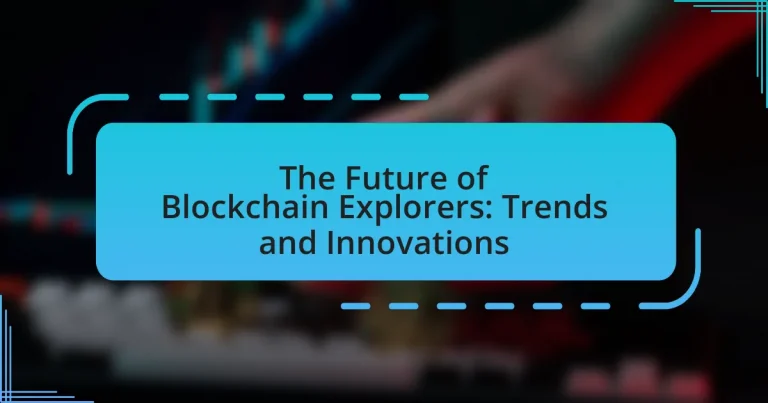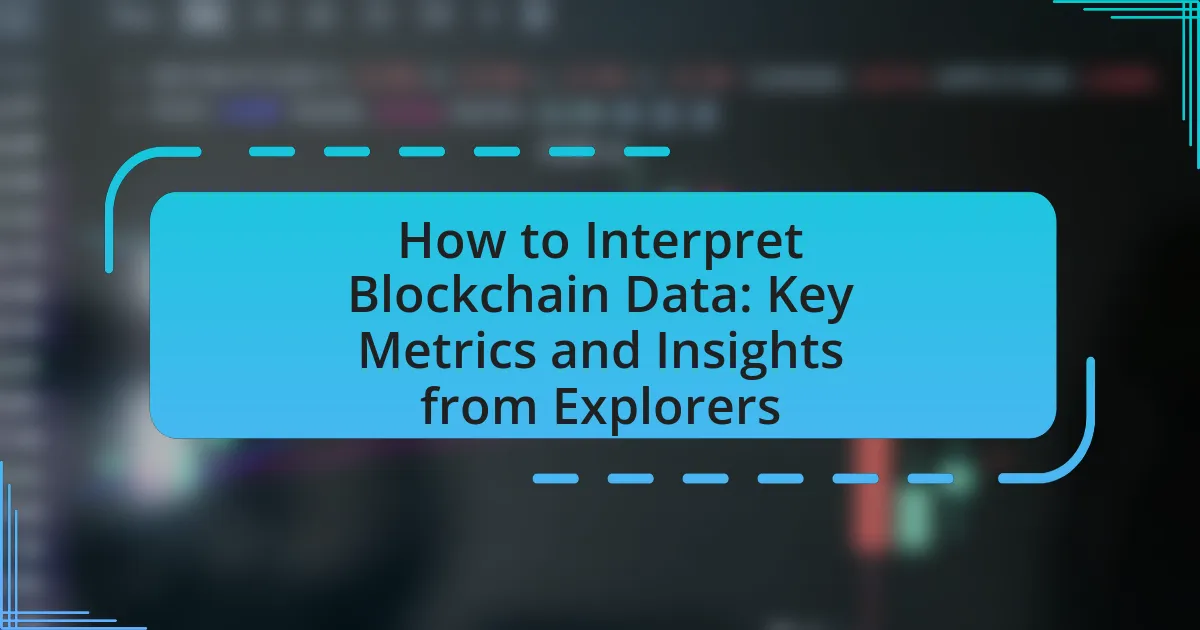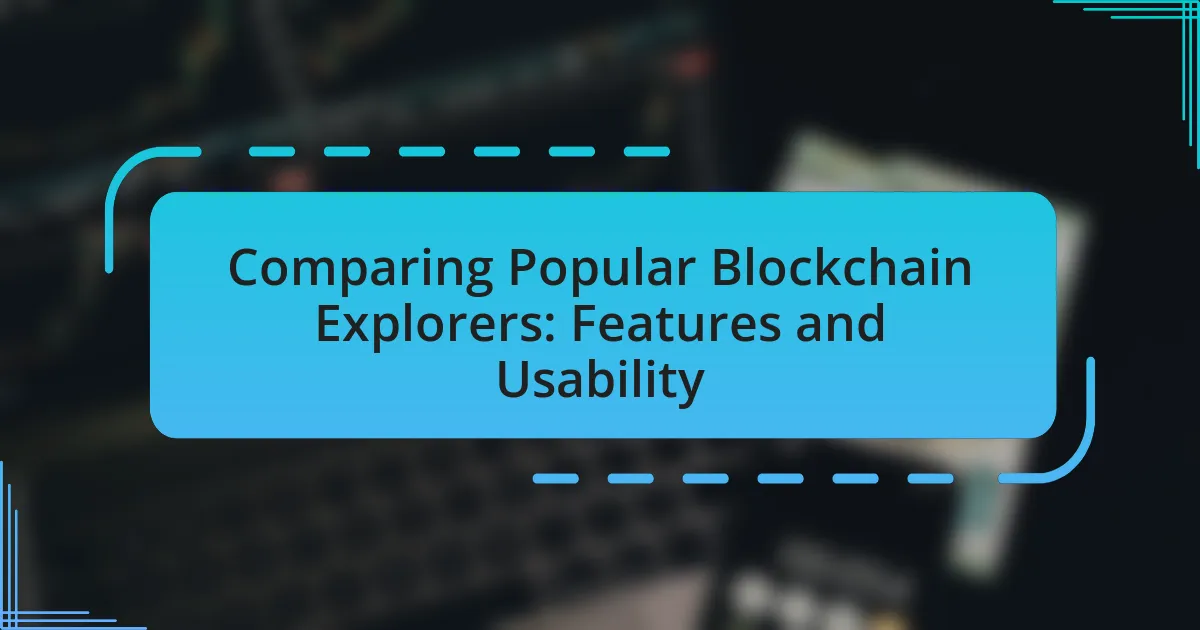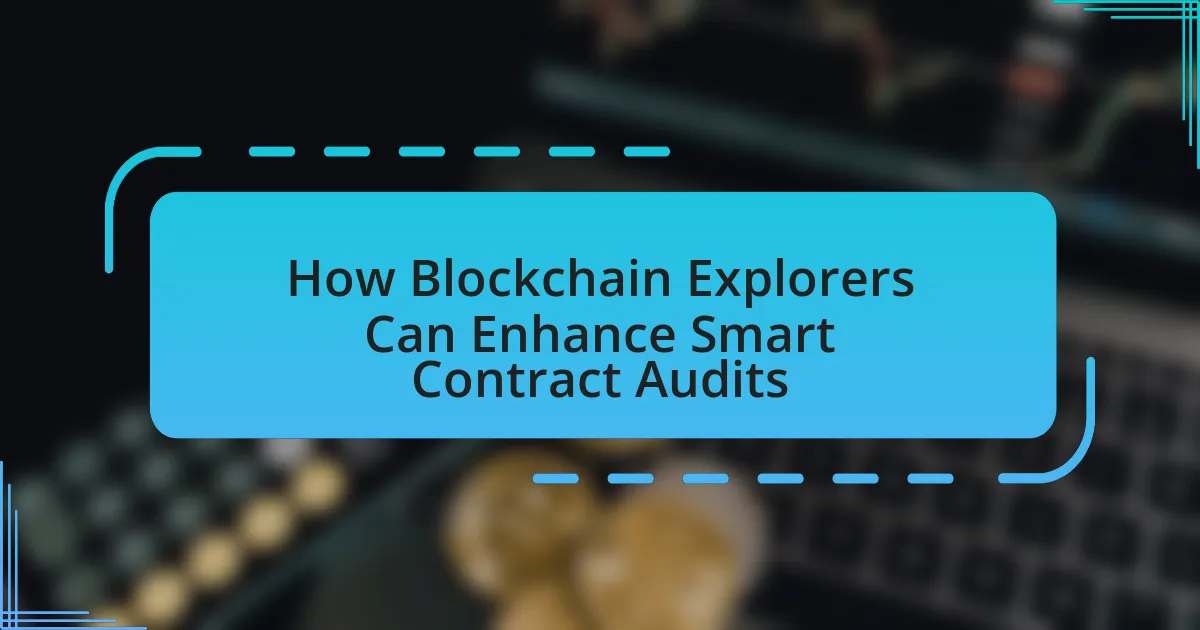Blockchain explorers are essential online tools that enable users to view and analyze transactions within blockchain networks, providing transparency and facilitating real-time monitoring of network activity. This article explores the role of blockchain explorers in enhancing user trust and security, detailing their functionality, underlying technologies, and key features. It also examines current trends in explorer development, including advancements in user experience, data visualization, and the integration of artificial intelligence. Furthermore, the article discusses the implications of interoperability and the evolving landscape of decentralized applications, highlighting the innovations shaping the future of blockchain explorers.
What are Blockchain Explorers and Their Role in the Ecosystem?
Blockchain explorers are online tools that allow users to view and analyze transactions on a blockchain network. They serve a critical role in the ecosystem by providing transparency, enabling users to track transaction histories, verify balances, and monitor network activity in real-time. For instance, Bitcoin blockchain explorers like Blockchair and Blockchain.com display detailed information about each transaction, including timestamps, amounts, and sender and receiver addresses. This transparency fosters trust among users and helps identify fraudulent activities, thereby enhancing the overall security of the blockchain network.
How do Blockchain Explorers function?
Blockchain explorers function by providing a user-friendly interface to access and analyze blockchain data. They allow users to view transaction histories, block details, and wallet balances by querying the blockchain’s public ledger. Each explorer connects to a specific blockchain network, indexing its data to facilitate quick searches and retrieval of information. For example, Bitcoin blockchain explorers like Blockchair or Blockchain.com enable users to track transactions by entering a transaction ID or wallet address, displaying relevant details such as timestamps, amounts, and confirmations. This functionality is essential for transparency and verification in decentralized networks, as it empowers users to independently verify transactions without relying on intermediaries.
What technologies underpin Blockchain Explorers?
Blockchain Explorers are primarily underpinned by technologies such as blockchain protocols, APIs, and databases. Blockchain protocols, like Bitcoin and Ethereum, provide the foundational structure for transaction verification and data integrity. APIs facilitate interaction between the blockchain and the explorer, allowing users to query data efficiently. Databases, often NoSQL types, store indexed blockchain data to enable fast retrieval and user-friendly interfaces. These technologies collectively ensure that Blockchain Explorers can present real-time information about transactions, blocks, and network statistics accurately and efficiently.
How do Blockchain Explorers interact with blockchain networks?
Blockchain explorers interact with blockchain networks by querying the blockchain’s public ledger to retrieve and display transaction data, block information, and wallet addresses. They utilize APIs and node connections to access real-time data from the blockchain, allowing users to track transactions, verify balances, and analyze network activity. For example, explorers like Etherscan and Blockchair provide detailed insights into Ethereum and Bitcoin transactions, respectively, by parsing the blockchain data and presenting it in a user-friendly format. This interaction is essential for transparency and accountability in blockchain ecosystems, as it enables users to independently verify the integrity of transactions and the overall health of the network.
What are the key features of Blockchain Explorers?
Blockchain explorers are tools that allow users to view and analyze blockchain data. Key features include transaction tracking, which enables users to see the status and details of transactions; block information, providing insights into the contents of specific blocks; and wallet address tracking, allowing users to monitor the activity associated with specific addresses. Additionally, many blockchain explorers offer search functionality, enabling users to find specific transactions or addresses quickly. They also often include visualizations of network activity and statistics, enhancing user understanding of blockchain dynamics. These features collectively facilitate transparency and accessibility in blockchain ecosystems.
What types of data can be accessed through Blockchain Explorers?
Blockchain explorers provide access to various types of data, including transaction details, block information, wallet addresses, and network statistics. Transaction details reveal the amount transferred, sender and receiver addresses, and timestamps. Block information includes block height, hash, and miner details. Wallet addresses allow users to track balances and transaction history. Network statistics provide insights into metrics such as hash rate, transaction volume, and network fees, enabling users to analyze blockchain activity comprehensively.
How do user interfaces enhance the experience of Blockchain Explorers?
User interfaces enhance the experience of Blockchain Explorers by providing intuitive navigation and clear data visualization. These interfaces simplify complex blockchain data, allowing users to easily track transactions, view block details, and analyze network activity. For instance, user-friendly dashboards can display real-time statistics and historical trends, making it easier for users to understand blockchain dynamics. Additionally, well-designed interfaces often incorporate search functionalities and filtering options, enabling users to quickly find specific transactions or addresses. This streamlined access to information significantly improves user engagement and satisfaction, as evidenced by studies showing that effective UI design can increase user retention rates by up to 200%.
Why are Blockchain Explorers important for users and developers?
Blockchain explorers are important for users and developers because they provide transparency and accessibility to blockchain data. Users can track transactions, verify balances, and monitor network activity in real-time, which enhances trust in the system. Developers benefit from explorers by gaining insights into transaction patterns, network performance, and potential issues, enabling them to optimize applications and improve user experience. For instance, as of 2023, popular explorers like Etherscan and Blockchair have processed millions of transactions, showcasing their critical role in facilitating informed decision-making within the blockchain ecosystem.
How do Blockchain Explorers contribute to transparency and trust?
Blockchain explorers enhance transparency and trust by providing real-time access to transaction data on a blockchain network. These tools allow users to view transaction histories, wallet balances, and block confirmations, ensuring that all activities are publicly verifiable. For instance, Bitcoin’s blockchain explorer enables anyone to track transactions, which fosters accountability and discourages fraudulent behavior. The immutable nature of blockchain records, combined with the accessibility provided by explorers, reinforces trust among users, as they can independently verify the integrity of transactions without relying on intermediaries.
What role do Blockchain Explorers play in transaction verification?
Blockchain explorers serve as essential tools for transaction verification by providing a transparent and accessible interface to view blockchain data. They allow users to track and confirm transactions by displaying details such as transaction IDs, timestamps, block confirmations, and the status of transactions on the blockchain. This transparency is crucial for ensuring the integrity of the blockchain, as users can independently verify that transactions have been recorded accurately and are immutable. Furthermore, blockchain explorers contribute to the overall security of the network by enabling users to monitor suspicious activities or discrepancies in transaction records, thereby reinforcing trust in the blockchain ecosystem.
What are the Current Trends in Blockchain Explorer Development?
Current trends in blockchain explorer development include enhanced user interfaces, integration of advanced analytics, and support for multiple blockchains. Enhanced user interfaces focus on improving accessibility and usability, allowing users to navigate complex data more intuitively. Integration of advanced analytics provides users with insights into transaction patterns and network health, which is increasingly important as blockchain technology matures. Support for multiple blockchains reflects the growing need for interoperability, enabling users to explore various blockchain networks from a single platform. These trends are driven by the increasing demand for transparency and usability in blockchain applications.
How is user experience evolving in Blockchain Explorers?
User experience in Blockchain Explorers is evolving through enhanced user interfaces, improved accessibility, and integration of advanced features like real-time data visualization. These developments aim to simplify navigation and make blockchain data more comprehensible for users. For instance, platforms are increasingly adopting intuitive designs and mobile-friendly layouts, which cater to a broader audience, including those without technical backgrounds. Additionally, the incorporation of features such as transaction tracking, analytics tools, and customizable dashboards allows users to interact with blockchain data more effectively. This evolution is supported by the growing demand for user-friendly solutions in the blockchain space, as evidenced by the increasing number of users engaging with these platforms, which has risen significantly over the past few years.
What innovations are being introduced to improve accessibility?
Innovations being introduced to improve accessibility include the development of user-friendly interfaces and enhanced data visualization tools in blockchain explorers. These advancements aim to simplify navigation and understanding of blockchain data for users with varying levels of technical expertise. For instance, projects like Blockchair and Etherscan have implemented features such as customizable dashboards and intuitive search functions, which facilitate easier access to blockchain information. Additionally, the integration of voice recognition technology and screen reader compatibility further enhances accessibility for individuals with disabilities, ensuring that blockchain data is available to a broader audience.
How are mobile applications changing the way users interact with Blockchain Explorers?
Mobile applications are transforming user interaction with Blockchain Explorers by providing instant access to blockchain data on-the-go. This shift enables users to monitor transactions, check wallet balances, and analyze blockchain activity in real-time, enhancing user engagement and accessibility. According to a report by Statista, mobile internet usage surpassed desktop usage in 2021, indicating a growing preference for mobile platforms. Furthermore, mobile applications often incorporate user-friendly interfaces and notifications, making it easier for users to stay informed about important blockchain events, such as transaction confirmations or price changes. This evolution in interaction is supported by the increasing number of blockchain-related mobile apps, which have surged to over 1,000 in various app stores, reflecting the demand for mobile solutions in the blockchain space.
What advancements are being made in data visualization within Blockchain Explorers?
Advancements in data visualization within Blockchain Explorers include the integration of interactive dashboards, enhanced graphical representations of blockchain data, and real-time analytics capabilities. These improvements allow users to better understand complex blockchain transactions and network activities. For instance, platforms are now utilizing advanced charting techniques and geospatial mapping to visualize transaction flows and user interactions, making it easier to identify trends and anomalies. Additionally, the implementation of machine learning algorithms is enabling predictive analytics, which enhances the ability to forecast network behavior based on historical data. These advancements collectively improve user experience and facilitate more informed decision-making in the blockchain ecosystem.
How do advanced analytics tools enhance the functionality of Blockchain Explorers?
Advanced analytics tools enhance the functionality of Blockchain Explorers by providing deeper insights into transaction patterns and user behaviors. These tools utilize machine learning algorithms and data visualization techniques to analyze large volumes of blockchain data, enabling users to identify trends, anomalies, and potential fraud. For instance, advanced analytics can reveal transaction clusters, helping to trace the flow of funds and understand the relationships between different addresses. This capability is crucial for compliance and security purposes, as it allows for real-time monitoring and reporting of suspicious activities. Additionally, the integration of predictive analytics can forecast future trends in blockchain usage, aiding businesses and investors in making informed decisions.
What are the implications of integrating AI into Blockchain Explorers?
Integrating AI into Blockchain Explorers enhances data analysis, improves transaction tracking, and increases user experience. AI algorithms can analyze vast amounts of blockchain data in real-time, enabling more efficient identification of patterns and anomalies, which is crucial for security and fraud detection. For instance, AI can facilitate predictive analytics, allowing users to forecast market trends based on historical transaction data. Additionally, AI-driven natural language processing can improve user interfaces, making it easier for non-technical users to navigate complex blockchain data. These advancements lead to more informed decision-making and greater accessibility in the blockchain ecosystem.
What security measures are being implemented in Blockchain Explorers?
Blockchain explorers implement several security measures to ensure data integrity and user safety. These measures include encryption protocols to protect data transmission, multi-signature wallets that require multiple approvals for transactions, and regular audits to identify vulnerabilities. Additionally, many blockchain explorers utilize decentralized architecture to reduce the risk of single points of failure, enhancing overall security. These practices are essential for maintaining trust and reliability in the blockchain ecosystem, as evidenced by the increasing adoption of such measures across various platforms.
How do Blockchain Explorers protect user data and privacy?
Blockchain explorers protect user data and privacy primarily through the use of pseudonymous addresses and limited data retention policies. Pseudonymous addresses allow users to interact with the blockchain without revealing their real identities, as transactions are linked to cryptographic keys rather than personal information. Additionally, many blockchain explorers implement data retention policies that minimize the storage of user data, ensuring that transaction histories are not permanently associated with individual users. This approach aligns with privacy-focused principles and helps mitigate the risk of data breaches or misuse.
What are the challenges in ensuring security for Blockchain Explorers?
Ensuring security for Blockchain Explorers faces several challenges, primarily due to the decentralized nature of blockchain technology. One significant challenge is the vulnerability to attacks such as Sybil attacks, where an attacker creates multiple identities to gain control over the network. Additionally, the lack of standardized security protocols across different blockchain platforms complicates the implementation of robust security measures. Furthermore, the transparency of blockchain can inadvertently expose sensitive data, making it susceptible to data breaches. According to a report by the Blockchain Security Alliance, 60% of blockchain projects have experienced security incidents, highlighting the critical need for improved security frameworks.
What Innovations are Shaping the Future of Blockchain Explorers?
Innovations shaping the future of blockchain explorers include enhanced user interfaces, real-time data analytics, and integration with decentralized finance (DeFi) protocols. Enhanced user interfaces improve accessibility and usability, allowing users to navigate complex blockchain data more intuitively. Real-time data analytics provide immediate insights into transaction trends and network performance, enabling users to make informed decisions quickly. Integration with DeFi protocols allows blockchain explorers to offer comprehensive views of asset movements and liquidity across multiple platforms, thereby enhancing the overall user experience. These innovations are critical as they address the growing demand for transparency and efficiency in blockchain transactions.
How is interoperability influencing Blockchain Explorer development?
Interoperability is significantly influencing Blockchain Explorer development by enabling seamless interaction between different blockchain networks. This capability allows Blockchain Explorers to aggregate and display data from multiple chains, enhancing user experience and providing comprehensive insights. For instance, projects like Polkadot and Cosmos focus on interoperability, which has led to the creation of Explorers that can track assets and transactions across various platforms. As a result, the demand for multi-chain support in Blockchain Explorers is increasing, driving innovation and the development of tools that facilitate cross-chain data visibility and analysis.
What are the benefits of cross-chain compatibility for users?
Cross-chain compatibility offers users enhanced flexibility and access to a broader range of decentralized applications and services. This interoperability allows users to transact and interact across different blockchain networks seamlessly, increasing the utility of their assets. For instance, users can leverage the strengths of various blockchains, such as speed, security, or specific functionalities, without being confined to a single ecosystem. Additionally, cross-chain compatibility can lead to reduced transaction costs and improved liquidity, as assets can move freely between platforms, facilitating better trading opportunities.
How do Blockchain Explorers facilitate multi-chain transactions?
Blockchain explorers facilitate multi-chain transactions by providing a unified interface to view and track transactions across different blockchain networks. They aggregate data from multiple chains, allowing users to monitor transaction statuses, verify confirmations, and analyze blockchain activity in real-time. This capability is essential for users engaging in decentralized finance (DeFi) and cross-chain applications, as it enhances transparency and simplifies the management of assets spread across various blockchains. For instance, explorers like Blockchair and Polkadot.js enable users to interact with multiple protocols seamlessly, demonstrating the growing trend of interoperability in blockchain technology.
What role do decentralized applications (dApps) play in the evolution of Blockchain Explorers?
Decentralized applications (dApps) significantly enhance the functionality and user experience of blockchain explorers by providing real-time data access and interactive features. dApps enable users to interact directly with blockchain networks, allowing for seamless transactions, smart contract execution, and data visualization. For instance, platforms like Etherscan integrate dApps to offer users tools for tracking token transfers, verifying contract interactions, and analyzing blockchain metrics. This integration not only improves transparency but also fosters a more engaged user community, as evidenced by the increasing number of dApps developed for various blockchain ecosystems, which has grown exponentially, reflecting a broader trend towards decentralized finance and governance.
How are Blockchain Explorers adapting to support dApp ecosystems?
Blockchain explorers are adapting to support dApp ecosystems by integrating enhanced features that facilitate user interaction and data accessibility. These explorers are now offering real-time transaction tracking, detailed analytics, and user-friendly interfaces that allow developers and users to monitor dApp performance and activity seamlessly. For instance, some explorers provide APIs that enable developers to access blockchain data directly, which is crucial for building and optimizing decentralized applications. Additionally, explorers are incorporating support for multiple blockchain networks, thereby broadening their utility for dApps that operate across various platforms. This evolution is evidenced by the increasing number of explorers that now include features like token tracking, smart contract verification, and community engagement tools, which collectively enhance the overall dApp ecosystem.
What features are essential for Blockchain Explorers to effectively serve dApps?
Blockchain explorers must have features such as real-time transaction tracking, comprehensive data visualization, and user-friendly interfaces to effectively serve decentralized applications (dApps). Real-time transaction tracking allows users to monitor the status of transactions as they occur, which is crucial for dApps that rely on timely updates. Comprehensive data visualization helps users understand complex blockchain data through charts and graphs, enhancing user experience and decision-making. User-friendly interfaces ensure that both technical and non-technical users can navigate the explorer easily, facilitating broader adoption of dApps. These features collectively enhance the functionality and accessibility of blockchain explorers, making them indispensable tools for dApp users.
What future trends should users anticipate in Blockchain Explorer technology?
Users should anticipate increased integration of artificial intelligence and machine learning in Blockchain Explorer technology. This integration will enhance data analysis capabilities, allowing for more sophisticated transaction tracking and anomaly detection. Additionally, the rise of multi-chain explorers will facilitate cross-chain interactions, enabling users to navigate multiple blockchain networks seamlessly. Enhanced user interfaces and real-time data visualization tools are also expected to improve user experience, making blockchain data more accessible and understandable. These trends are supported by the growing demand for transparency and efficiency in blockchain applications, as evidenced by the increasing number of blockchain projects and the need for robust analytical tools in the industry.
How will emerging technologies like quantum computing impact Blockchain Explorers?
Emerging technologies like quantum computing will significantly impact Blockchain Explorers by enhancing their computational capabilities and security measures. Quantum computing can process complex algorithms at unprecedented speeds, which may improve the efficiency of data analysis within blockchain networks. Additionally, quantum algorithms could potentially break traditional cryptographic methods used in blockchain, prompting the need for quantum-resistant cryptography to secure transactions and data integrity. This shift is supported by research from the National Institute of Standards and Technology, which is actively developing post-quantum cryptographic standards to address these vulnerabilities.
What best practices should users follow to stay updated with Blockchain Explorer innovations?
To stay updated with Blockchain Explorer innovations, users should regularly follow reputable blockchain news websites and subscribe to industry newsletters. These sources often provide timely updates on new features, technological advancements, and emerging trends in blockchain exploration. Additionally, engaging with community forums and social media platforms dedicated to blockchain discussions can facilitate real-time information sharing and insights from experts. Participating in webinars and attending industry conferences also allows users to gain firsthand knowledge about the latest developments. According to a report by CoinDesk, staying informed through these channels significantly enhances users’ understanding of the evolving blockchain landscape.





